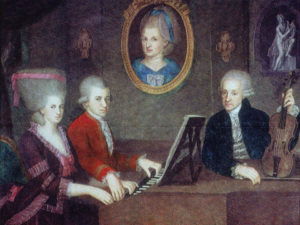We go over what we call a “minor deflection” that occurs during the 4th movement of Mozart’s “Jupiter” Symphony. Using a MITA Interactive Score to follow along with and navigate around the notation, we examine how Mozart uses this device, reminiscent of his opera writing, to build surprise into the beginning (exposition) and end (recapitulation) of the movement. Beginners welcome! Experience this Interactive Score and many more with the free MITA Sampler.
Video Transcript
Hello, and welcome to a MITA Musical Languages Moment! I’m Stefan, and today we’ll be looking at a little device from the fourth movement of Mozart’s “Jupiter” Symphony. This movement isn’t exceptional because of any single theme but rather for the seemingly endless ways that Mozart’s able to twist the themes to different ends, moving naturally between heady fugues and the comedic buffo style until by the end he’s juggling all four themes at once.
There’s plenty to say about this movement, but I want to examine just one particular moment that occurs between the first and second themes of the closing area. I’ve got my MITA Interactive Score up, and we can see that we’re in the closing area and we’re chugging along comfortably in the dominant key of G Major, or, better yet, let’s hear G Major. I’m gonna pause it with my space bar, and there’s a nice G-Major cadence. It sounds like we’re gonna get the same thing again… until all of a sudden we’re hit by a huge C-Minor chord, or a minor-iv chord. After about three seconds Mozart lifts the chord back to C-Major, and these chromatic C-sharps and D-sharps that follow give us the sense of hoisting ourselves back up to the safety of this G-major cadence. We can call this episode a minor-mode deflection. Let’s hear what the whole thing sounds like from the beginning of the closing area.
This is classic Mozartian opera stuff: a fleeting glimpse into the infernal. We get the same thing when the closing area comes back in the recapitulation towards the end of this movement, but this time, like so much else in this piece, Mozart squeezes extra juice out of the minor deflection idea by expanding on it through the use of Neapolitan and German sixth chords. Let’s listen to the closing area in the recapitulation and hear what this sounds like.
Thanks for watching. If you liked the video, prove it, and don’t forget to subscribe to our channel. Use the link in the description to download the free MITA Sampler and see the Interactive Score to Mozart’s “Jupiter” Symphony in action. You’ll find the tip from this video and lots more via the purple “More” buttons at the bottom of many of the pages. See you next time!




2 Responses
Stefan,
I love your new blog post on the Jupiter finale.
Focusing a bit on the bass line: instead of the previous e, Mozart goes a half step lower to e flat and then progresses upward, back to the tonic, thereby intensifying what he had already accomplished. You focused on the harmonic; I have focused instead on the contrapuntal. Both are important parts of what we hear.
Bravo again.
Bob
Great insight — thank you, Bob!